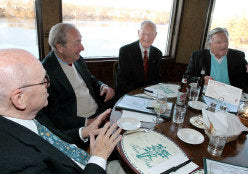Toasting Narragansett Beer Celebrating Narragansett Brewery's 120th anniversary
Friday, December 17, 2010
By Donita Naylor
Journal Staff Writer
CRANSTON - Talk about a liquid lunch.
Well, the talk at lunch was about liquids. All eight men seated at Twin Oaks ordered food Thursday and talked about Narragansett Beer.
The eight men - five former executives of the old Narragansett Brewery, two new executives trying to get the
resurrected brand brewed and bottled in Rhode Island and one former beer salesman who is also a former governor of Rhode Island were celebrating the brewery's 120th anniversary.
Six German-Americans opened the original brewery in Cranston on Dec. 29, 1890, and decided to name it after Narragansett Bay.
'Anybody need a drink?' the waiter asked.
Almost everyone seated in the corner overlooking Spectacle Pond, less than a mile from where the brewery used to be, had a 'Gansett. The lagers on the table were bottled in Rochester, N.Y., at a Genesee operation, said Jim Crooks, a vice president of the comeback company, who was too young to drink when the Cranston brewery closed.
Some Narragansett beers are still made locally, Crooks said. Small batches are crafted in Providence, at the Trinity Brewhouse on Fountain Street, and larger contract batches are brewed just over the Westerly line, at the Cottrell Brewery in Pawcatuck, Conn.
In 2005, Mark Hellendrung and Crooks, who had worked together at Nantucket Nectars, started the new company. They asked Bill Anderson, a former brewmaster at the Cranston plant, to make the formula as close as possible to the original, 'to help us re-create the glory days,' when Narragansett Lager Beer sponsored the Red Sox, announcer Curt Gowdy sang the jingle, and the brand dominated beer sales in New England. Anderson was in California and couldn't make the lunch, Crooks said.
Former owner David Haffenreffer said the brewery played an important part in his family. His grandfather acquired the brewery, 'bought it cheap,' while Prohibition was still going on and the brewery survived by making and delivering ice, making soda and near beer, and brewing small amounts of beer for medical uses.
Hellendrung asked if Haffenreffer remembered his first day. The son and grandson of owners, as well as owner-to-be, said he started in a warehouse, making sure the advertising materials - posters and die-cut cardboard stands - got on the trucks for delivery to package stores and drinking establishments.
Some of the advertising items had a way of walking off, so it helped to be an owner. He'd be in the warehouse saying: 'I gave you 15.' 'Well I only got 12.' 'I gave you 15 so get out of here.'
Beer could be a 'bare-knuckle fighting game,' he said, but people took pride in their state and beer. 'There was a real ethic of producing a good product,' Haffenreffer said.
Former beer salesman J. Joseph Garrahy, 80, who remembers stacking beer in advertising displays, said the company was a good corporate citizen. After a flood in Woonsocket, he remembered Thursday, the company sent cases and cases of water it had bottled for townspeople.
Herb Browne, the same age as Garrahy and a fellow salesman, said Garrahy was 'just a great, great guy' when he sold beer, and he didn't change as governor, and he's still the same.
Bill Considine Jr. credits his father, who was executive vice president, with two ideas that were 'absolutely important to the company's success,' selling beer in 16-ounce bottles, and of selling imperial, or Canadian, quarts of 35 rather than 32 ounces.
They talked about the radios that looked like barrels flanked with a 'Gansett bottle on each side. People used to sit in bars and listen to the Red Sox games on those, said Joe O'Neil.
They've been seen on eBay for $200 to $300.



